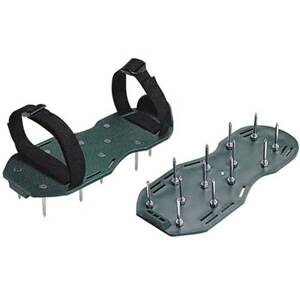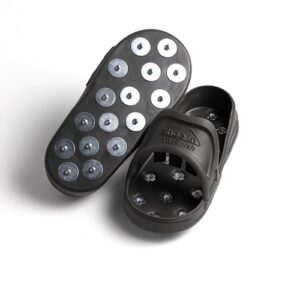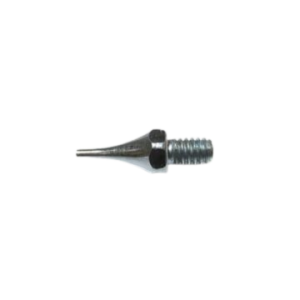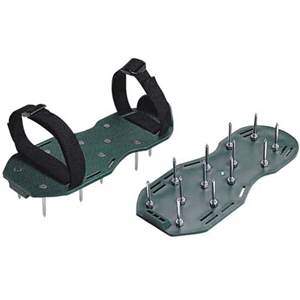Why Spiked Shoes for Flooring are an Essential Tool
The most helpful equipment to reduce the time you spend on flooring is the spiked shoes. Rather than tiptoeing around fresh compound, you can stand steady as you normally would, without leaving footprints or impressions. As essential flooring tools, spiked shoes for flooring are high on our list.
What are Spike Shoes?
Spiked screeding shoes are also called epoxy shoes or screeding shoes. They come in two types, which have various benefits and drawbacks.
The most common type is a rigid plastic (polypropylene) undershoe that straps onto the base of your work boots. These each have approx. 16 hardened steel spikes bolted through at regular intervals to support your weight, an inch or more above the compound. Spikes come in 1 or 2-inch sizes.

Screeding soles are often the cheaper option, and more versatile as you can fit it under any steel-toe boot. However, their straps can loosen and drag in the screed if unnoticed, and the bolts can also loosen, so make sure you check the bolts before every use.
The other type of spike shoes is rubber slip-on overshoes designed without fabric straps. The spikes are secured directly to the rubber, so don’t loosen, making these the safest epoxy/screeding shoes on the market.

The spikes are less than 1 inch, making these less suitable for deep compound, but they are more than adequate for most jobs.
It should be noted that spike shoes are entirely different from crampons or running spikes.
Why are they beneficial for flooring?
Spike shoes change the game when you’re using self-levelling flooring screed, epoxy flooring, paint, or adhesive. Because your weight is evenly distributed across several narrow points, you can walk on freshly applied surfaces without slipping, adding dirt or ruining the floor.
Wearing spikes improves safety and balance during the job, as they provide a good grip and allow you to walk on all areas of the floor. There’s no risk of painting yourself into a corner.
Being able to walk on a wet floor without spoiling it saves floorfitters a lot of time. The work can be done in one go, rather than in sections, and you can move with confidence without having to repeat work when stepping by accident.
Spiked soles are not just for screeding, as we mentioned before. You can wear them when spreading epoxy, applying primers or coating, painting floorboards or spreading tile adhesive. There are many compounds we apply to floors during fittings, and these handy shoes are compatible with most of them.
Choosing Spiked Shoes
There aren’t many different types of flooring spikes, so the choice seems straightforward. However, these are the things to consider to make sure you get the best spike shoes for you.
Sizing
Rigid soles are a single standard size. At 32.5cm long, they will fit up to size 12 boots. The adjustable straps tighten around the shoe to secure the soles on any size.
Spiked rubber overshoes are available in two size ranges, sizes 8-10 and sizes 10-15. They are designed to fit over your existing work boots, but the sizes are listed according to shoe size to make choosing easy.
Comfort
The most comfortable are the Shoe-In Spiked Sole. They are more flexible than rigid soles, and fit securely over shoes without straps or bolts that can loosen.
Sharp or Blunt spikes
Blunt flooring spikes can be used for high build coatings, cementitious compounds and some decorative concrete toppings.
You can also replace Shoe-In spikes with sharper spikes, designed for self-levelling installation, epoxy coatings, and decorative concrete, which require less disturbance.

Spike length
If spikes are too long, they can drag in the compound when walking, creating track marks.
If spikes are too short, they will not lift the wearer high enough above the layer, leaving footprints.
Choose from 1-inch spiked soles, 2-inch spiked soles, or ¾ inch spiked soles. The right answer depends on the depth of the compound you most frequently use, but it may be worth investing in additional spikes so you can adapt.
Cost
The difference that makes a difference to most floor fitters and DIY-ers is the price of the product. If you’re working on a tight budget, the rigid spiked soles are the obvious choice at less than £20 a pair. That they need frequent tightening and strap checking may well be worth the savings.
If you’re investing in premium spike shoes as this is a major part of your business, Shoe-in’s rubber option is a good choice. They are quicker to put on over your shoes, have more sturdy fixings and no straps that may loosen or drag in your compound. All of these small things add up to a lot of time saved on the job.
How to Wear Spike Soles
It’s not rocket science, but the basic process of putting on flooring spikes is as follows.
- Check all bolts are as tight as possible to avoid wobbly spikes.
- Make sure the soles are clean of all dust and debris, as you don’t want to transfer this to your new floor.
- Secure the soles under your shoes or boots.
- Tighten the straps and tuck them in securely so that they don’t drag in the compound.
Walk carefully and deliberately when wearing spikes, both for safety and to avoid creating swirling or displacement in the compound. Make no sudden turns and keep your weight evenly distributed across the whole sole. This will help you avoid falling into your self-levelling compound.
Spiked Shoes for Flooring – FAQs
Can I reuse spiked shoes?
As many times as you like, as long as there are no cracks or splits in the soles. Clean them thoroughly between jobs using a scraping tool or solvent to avoid old compound dropping into the new floor on your next job.
Are spiked shoes safe on all surfaces?
Spiked shoes are designed for wet, uncured surfaces such as freshly-poured self-levelling concrete or epoxy. They are not safe to use on dry or semi-set surfaces, as they can damage the floor and cause accidents.
Only wear spiked shoes during the open working time of the material. Site supervisors should assess curing progress before allowing walk-throughs.
How long will they last?
Polypropylene is a highly durable plastic, and the lifespan of your spike soles depends on how frequently you use them and the strain they take during use. Improper use will lead to cracks and breaks, such as dragging the feet or walking quickly on dry surfaces.
Will they damage carpet or vinyl?
In most cases, yes. Spikes are not designed for walking on dry surfaces, let alone soft or fibrous flooring. Sheet vinyl or linoleum will likely be punctured by sharp spikes and dented by blunt spikes. Carpet can catch and fray or cause trips and falls, depending on the pile. Only wear spikes on freshly laid wet compounds.
The Best Spikes for Flooring Preparation
Choose spiked shoes for flooring preparation from our comprehensive range. We supply rigid soles with long or short spikes as well as premium rubber overshoes with the most secure flooring spikes on the market. You can also find replacement spikes for screeding shoes with both sharp and blunt tips, so you’ll be prepared to work with any type of flooring compound.
Browse Spike Shoes for Flooring




